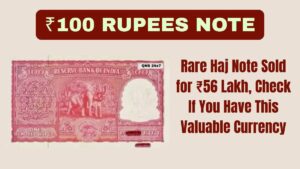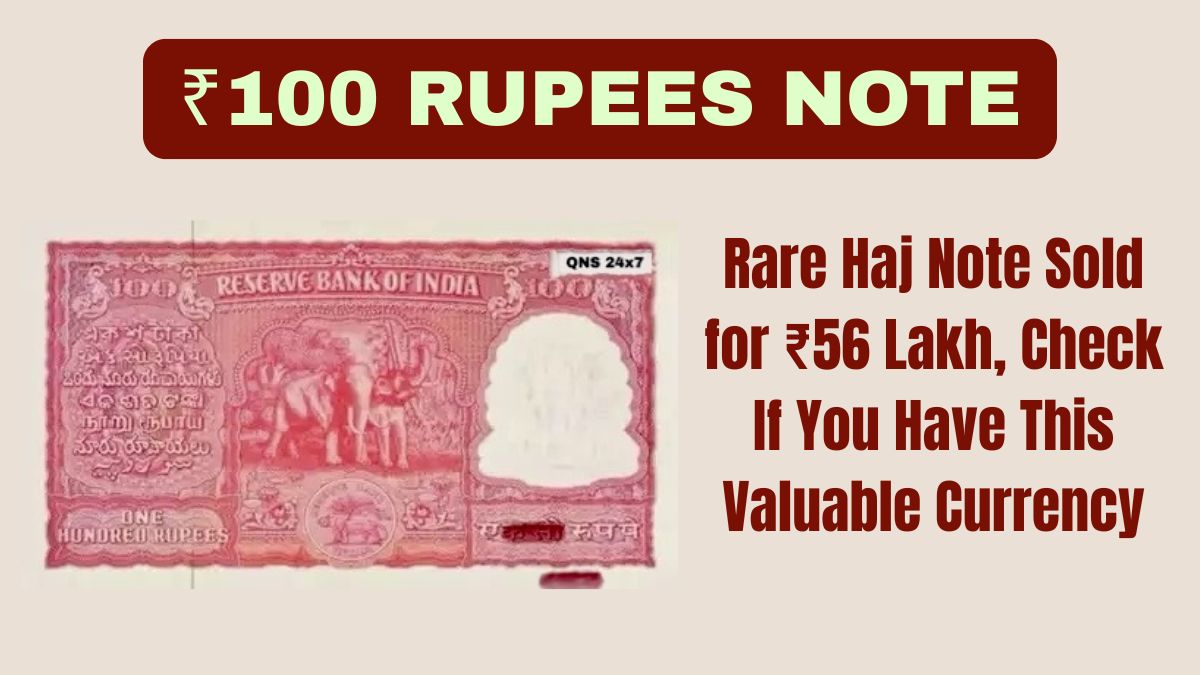The world of currency collection continues to surprise with unbelievable valuations. In September 2025, a rare ₹100 Haj Note was sold for an astonishing ₹56 lakh at a collector’s auction. This unique piece of Indian currency, issued decades ago for Haj pilgrims, has now become one of the most sought-after notes among numismatists and collectors. The news has sparked a fresh wave of interest, with people checking their old trunks, almirahs, and family savings to see if they might own this valuable piece of history.

What is the ₹100 Haj Note?
The Haj Note was a special issue by the Reserve Bank of India (RBI) for use by Indian pilgrims traveling to Saudi Arabia for Haj in the mid-20th century. During that time, foreign exchange regulations restricted Indians from carrying regular rupee notes abroad. Instead, the RBI issued special notes that could be exchanged with Saudi riyals once the pilgrims arrived in Mecca.
These notes were similar in design to regular ₹100 notes of that era but had special identifiers distinguishing them from normal currency. After the scheme ended, most notes were withdrawn, but a few remained in circulation or in private collections, which today makes them highly valuable.
Features That Make the Haj Note Rare
-
Distinctive Markings: The Haj notes carried markings or stamps in Urdu and English identifying them as Haj issues.
-
Limited Circulation: They were not used widely within India and were specifically meant for pilgrims.
-
Historical Connection: Directly linked to India’s cultural and religious history, making them more valuable.
-
Withdrawal by RBI: Since these notes were discontinued, only a limited number survive today.
-
Condition Matters: Notes in mint or uncirculated condition can fetch prices much higher than those that are worn or damaged.
Why Did the Note Sell for ₹56 Lakh?
The ₹100 Haj Note recently sold at auction attracted bidders because of its rare serial number, pristine condition, and historical relevance. Collectors often pay a premium for notes that combine rarity with cultural significance. While the face value was only ₹100, its auction value skyrocketed due to demand from both Indian and international collectors.
Current Market Value of Haj Notes
-
Average Condition Haj Notes: Can sell anywhere between ₹50,000 and ₹2 lakh.
-
Well-Preserved Notes: May fetch ₹5 lakh to ₹10 lakh.
-
Rare Serial Numbers or Mint Condition: Can exceed ₹50 lakh, as witnessed in September 2025.
This shows how the collectible value of currency can grow exponentially when supply is limited and demand is high.
How to Identify If You Have a Haj Note
-
Check the Printing Year: Notes from the 1950s to the 1970s may have Haj issues.
-
Look for Special Markings: Haj notes have Urdu inscriptions and special identifiers.
-
Compare With Regular Notes: They may look similar, but Haj notes carry distinct differences.
-
Verify Serial Numbers: Some rare serials or prefixes are especially prized.
-
Condition of the Note: Crisp, unstained notes hold much higher value.
If you suspect you have one, consult a currency expert or auction house for verification.
Why Collectors Value Rare Notes
Rare notes like the Haj issue attract attention for multiple reasons. They are not just currency but historical artifacts. Collectors, also called numismatists, see them as tangible connections to the past. The cultural importance of the Haj pilgrimage adds emotional value, while the RBI’s decision to discontinue the scheme ensures scarcity. Together, these factors drive demand and raise auction prices.
Legal Aspects of Owning Rare Notes
In India, owning and trading old currency notes is generally legal as long as it is for numismatic or collection purposes and not for circulation as legal tender. However, selling extremely rare notes should ideally be done through registered auction houses to ensure transparency and authenticity. It is important to note that these notes are not valid for everyday transactions and hold value only in the collectors’ market.
Tips for Selling Rare Currency
-
Get the Note Authenticated: Consult experts to verify authenticity.
-
Check Auction Houses: Established firms like Todywalla Auctions and Marudhar Arts specialize in currency.
-
Avoid Online Scams: Many fraudsters pose as buyers; always verify credibility.
-
Preserve the Note: Store in protective covers to maintain condition.
-
Track Market Trends: Prices fluctuate depending on collector demand.
Should You Search for Old Haj Notes Now?
With the recent sale making headlines, many Indians are rushing to check family safes and old collections. If you discover a Haj Note, its value will depend on factors such as condition, rarity, and serial number. Even if it does not fetch crores, it can still be worth thousands or lakhs.
Verdict: Why the ₹100 Haj Note Matters in 2025
The sale of a ₹100 Haj Note for ₹56 lakh in September 2025 is not just a financial story but also a cultural one. It highlights how currency can transcend its monetary value and become a priceless collectible tied to history and tradition. For investors and collectors, such notes serve as both a rare asset and a piece of heritage. If you own one, you could be holding something far more valuable than its face value suggests.
FAQs
What is a Haj Note?
A special ₹100 note issued by the RBI for Indian pilgrims traveling to Saudi Arabia for Haj in the mid-20th century.
Why is the ₹100 Haj Note valuable?
Because of its rarity, cultural significance, and limited circulation, collectors are willing to pay lakhs for it.
How much did the rare Haj Note sell for in 2025?
It was sold for ₹56 lakh in September 2025 at a collectors’ auction.
Can I legally sell a Haj Note in India?
Yes, you can sell it for collection purposes through verified auction houses and dealers.
How do I check if my old note is a Haj Note?
Look for Urdu inscriptions, unique identifiers, and check the printing year with an expert
Click here to know more.
